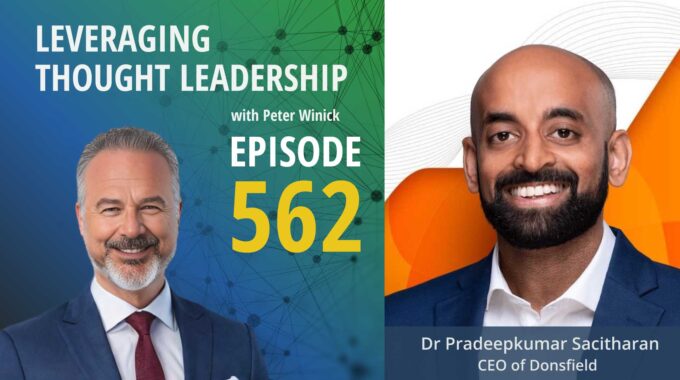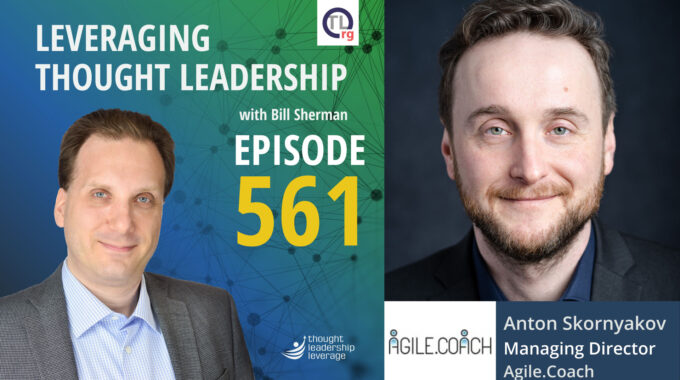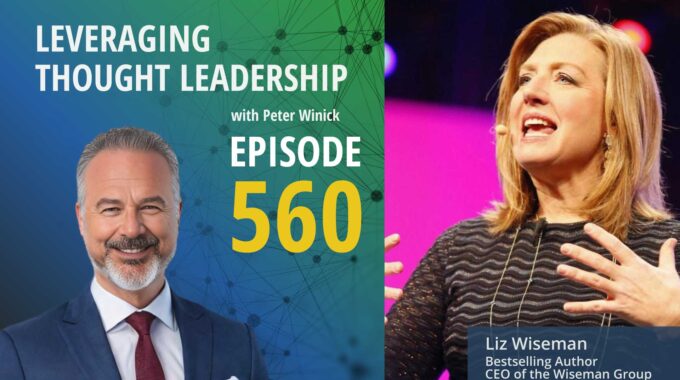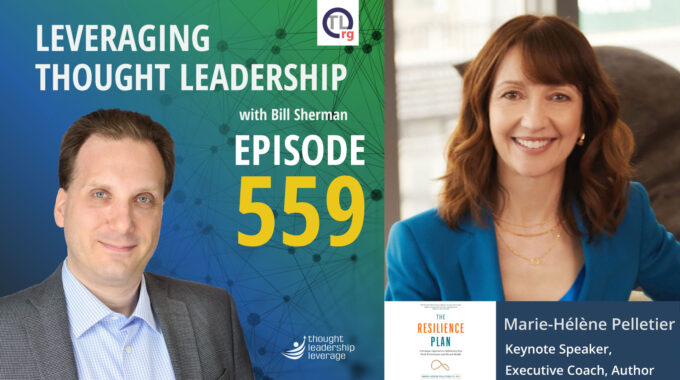Practical Advice for Thriving in Today's Leadership Landscape A conversation with Dr. Pradeepkumar Sacitharan about…
Using Thought Leadership to Create Influence and Impact | Meghan Quinn
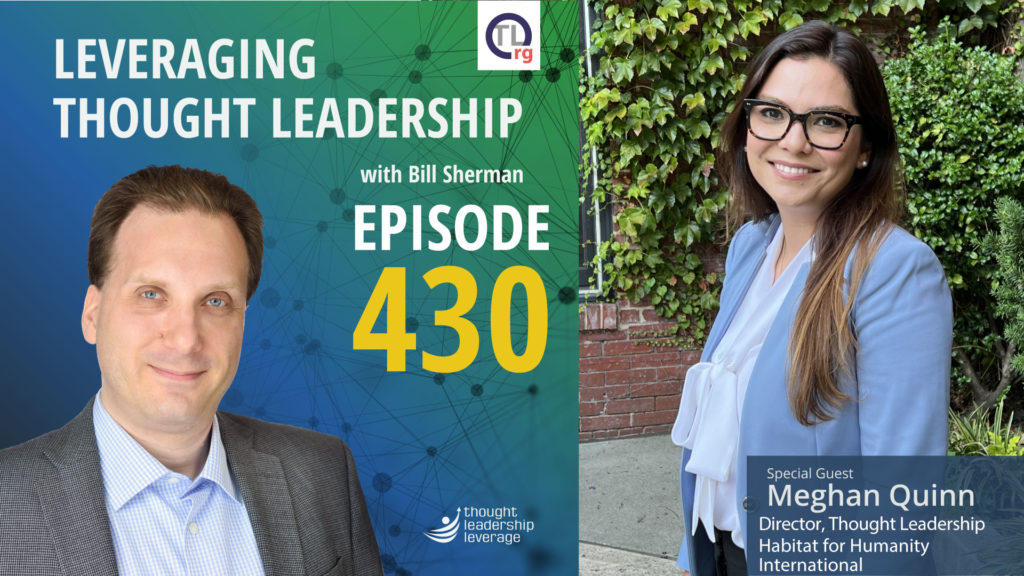
How thought leadership can expand reach for non-profit organizations.
An interview with Meghan Quinn about expanding the influence of a well-known organization through thought leadership.
There are a lot of hard-working thought leadership practitioners in the non-profit sector!
What’s it like to face the challenge of communicating complicated, multi-generational problems to a global audience?
We’re glad you asked!
To better understand the role thought leadership plays at established non-profits, I’ve invited Meghan Quinn, Director of Thought Leadership at Habitat for Humanity International, to chat with me about her work.
Meghan defines her role, elaborating on the meaning of thought leadership means at Habitat for Humanity. In a non-profit, conversations around thought leadership often start by focusing on the role and goals of the greater organization: for Habitat, that’s the global affordable housing crisis.
In order to have a real impact, Meghan’s work needs to reach policymakers, stakeholders, and donors. Meghan tells us how moving these people to action means taking technical research and creating content that is both curated and simple-to-approach. Rule #1: If your audience doesn’t understand what you’re saying, and why, they certainly won’t be moved to act on your information.
As with many thought leadership programs, measuring success can be a difficult task. Sales data and leads aren’t as tangible in the non-profit sector. Meghan shares how success at Habitat is measured, through anecdotal evidence, making connections with new backers, and deepening relationships. Her primary goals are to spread the word, and to increase credibility and trust in the organization. This kind of vision can’t be measured in weeks or months – it can take years to see real results on a global scale.
This conversation gives a glimpse into the unique world of thought leadership in the non-profit sector, and offers valuable insights for organizational thought leaders everywhere!
Three Key Takeaways:
- Curation and Digestibility are the keys to making complicated data into something a general audience can understand.
- Thought Leadership isn’t successful overnight. A plan and vision that spans years is needed to properly measure success.
- Thought leaders need to be able to follow their instinct and not be afraid to experiment – and even fail from time to time.
If you need a strategy to bring your thought leadership to market, Thought Leadership Leverage can assist you! Contact us for more information. In addition, we can help you implement marketing, research, and sales. Let us help you so you can devote yourself to what you do best.
Join the Organizational Thought Leadership Newsletter to learn more about expanding thought leadership within your organization! This monthly newsletter is full of practical information, advice, and ideas to help you reach your organization’s thought leadership goals.
And if you need help scaling organizational thought leadership, contact Thought Leadership Leverage or reach out to Bill Sherman on Linkedin!
Transcript
Bill Sherman How do you use ideas to create influence and impact around complicated, multi-generational challenges? For example, what should you do if your thought leadership work revolves around solving problems like affordable health care worldwide? There’s a whole cohort of nonprofit organizations that are charting ways forward through thought leadership. And today I speak with Megan Quinn, who is the director of Thought Leadership and Habitat for Humanity International. We talk about her work and Habitat to create a shared internal understanding about thought leadership, her work to define audiences in planning and measuring campaigns. Finally, we talk about how Megan came to thought leadership and how her background in politics and communications influences her work today. I’m Bill Sherman and you’re listening to Leveraging Thought Leadership.
Bill Sherman Ready? Let’s begin. Welcome to the show, Meghan.
Meghan Quinn Thanks. Thanks, Bill, for having me.
Bill Sherman So, Megan, let’s start with a basic question. What is thought leadership for you and Habitat?
Meghan Quinn Sure. Well, thanks, Bill. And I think any conversation that begins about thought leadership should kick off with a definition. It’s a sort of ambiguous term and can mean different things to different people. So, I sort of joke that I spend a lot of my time defining thought leadership itself, but also in my role within Habitat and sort of on the thought leadership front. So, for Habitat thought, leadership is about influence. We want to define the affordable housing issue globally. Elevate the issue for general audiences and then provide habitat work as an example of ways we can move forward in sort of alleviating the affordable housing issue globally.
Bill Sherman And you alluded to it. So, I’m going to follow up. You said you spend a lot of time defining your role. How does your role fit into that?
Meghan Quinn So my role is actually new within the Habitat organization. Habitat has been doing thought leadership work over the last many years but having our thought leadership work under one umbrella is allowing us to have a more cohesive and strategic approach to our work in the US as well as our work globally. Making sure that we are elevating. Programs that we’re working on, sort of moving forward in habitats, credibility and name recognition and talking about the kind of innovative work that we’re doing now.
Bill Sherman It sounds like and I’ve heard this from other people in a similar position, you’re curating a lot of ideas and making sure they get to the right audience. Is that a fair summary?
Meghan Quinn Yes. And I would kind of. Think of two words when I think of thought leadership. One is curation, which you just pointed out. What are we saying? What are we elevating? What are we highlighting? And then digestibility, how are we saying it and how are we reaching audiences? So, it’s a sort of combination of the two. Some topics may be more suitable for certain audiences, but really the two kinds of going hand in hand of What are we saying? And then how are we saying it?
Bill Sherman So let’s dive a little bit deeper on digestibility, because I think that’s an interesting issue and challenge for thought leadership. Now, as people’s attention spans get shorter and shorter, and we have so much more information passing in front of our eyes every day. My sense is Habitat creates a lot of research and very deep, thoughtful technical work. How do you make that digestible for someone even on first pass?
Meghan Quinn Sure. So, I sort of think of dissemination of thought, leadership work in a reverse triangle funnel. So, you have your general audiences at the top and then you kind of go down to expert audiences most technical, most niche, most within the sector in which you’re working. I think the trick is taking the different pieces of information you’re creating, taking the programs you’re working to drive forward, and tailoring the information that you’re providing externally to those specific audiences. Is it a general audience that wants the top line? Is it a policymaker who wants to know the impacts to their community or larger sort of advocacy related issues? Is it a subject matter expert who wants to know the kind of nitty gritty of the program, the cost, how you’re scaling those types of things? And so for the thought leadership work that I do, we’re focusing more on those top tier audiences. So more the general audiences, more of the policymakers, stakeholders, global and domestic donors. How is the money that they are spending being used in a productive way? What are programs that could be funded to help different communities using different approaches? So, the taking, the more technical work that would be appropriate for just as a kind of a white paper that may go to a certain technical audience. How do we take the high-level points and make that friendly for a general audience or a policymaker audience?
Bill Sherman And you talked early about the concept of influence. I want to circle back to that, because many organizations, when they use thought leadership, are looking from either a lead development pipeline perspective or they may be looking from a talent development perspective, recruiting talent, retaining talent, developing talent. Here you’re playing in the world of influence. It’s not that Habitat has something to sell directly to a policymaker. And I think that shapes some of the nuance of thought leadership. And it’s really impactful work because of thought leadership.
Meghan Quinn Yeah. And I mean, that’s such a great point. And I think particularly because we don’t in the thought leadership sort of space, that habitat and habitat more broadly perhaps since we don’t have that kind of maybe dollar measurement or if you’re in sort of a different perspective of thought leadership in terms of leads generated, having a really good sense of what your outcomes and goals are at the start is critical. I think that having that sort of outcome driven planning really sets us up for success. As I mentioned earlier, having thought leadership under one position and one umbrella is new. So at the outset, determining not only the definition but also what success looks like in year one, year two out to year five. So that in conjunction with defining what you’re doing and the thought leadership work, you’re also saying this is where we’re going. These are the deliverables we want to provide. These are the sort of support we need from programs, advocacy and in order to sort of achieve those goals. I think additionally. Sort of, as we mentioned, with less, I think perhaps data driven. Things to point to as successes are. Outcomes are perhaps more anecdotal and can be less hard to pinpoint. So your point, as we’ve discussed about influence, how do you measure influence or how do you describe success at an external conference? How do you define success in earned media over time? How do you define success around deepening relationships with other influential organizations, partners, etc.? So, a lot of those outcomes are inherently anecdotal, but I think being able to link those dots and those successes is as important to building credibility internally as it is externally.
Bill Sherman Absolutely. And I think one of the roles of someone who is curating thought leadership is the ability to collect anecdotes and at least take the next step to what I call ethnic data. Right. And so, for example, your conference example, you could say, okay, we had a list of 20 people that we wanted to chat with in one on ones, whether at the coffee stand, etc., or at a breakout, etc. Did we talk to them? Are they in an awareness phase of the idea? Do they agree with us? Are they acceptance? Are they activated and they ready to take action? You can start mapping some of that if you have the strategy before, but if you roll into a conference either as an individual or as a team and you don’t have that plan and you don’t have sort of that target list of what are you talking about? With whom then all you have is anecdotes.
Meghan Quinn Yeah, absolutely. And in addition to having a broader thought leadership strategy and then tactics around earned media owned channels, making connections with other people of influence at external events or conferences, I think it’s important to note that thought leadership is an inherently sort of relationship driven area of communications and external communications and being able to build those relationships in meaningful ways that then drive other successes. Perhaps you meet someone at a conference. Talking about the importance of affordable housing. And then in a year you’re doing a joint op ed with them. But having all of that under one strategic sort of goal-oriented approach helps connect those dots and helps drive more measurable successes in the future.
Bill Sherman If you are enjoying this episode of Leveraging Thought Leadership, please make sure to subscribe. If you’d like to help spread the word about the podcast, please leave a five-star review and share it with your friends. We are available on Apple Podcasts, Spotify, and all major platforms as well as at LeveragingThoughtLeadership.com.
Bill Sherman So one of the ways that if it was a sales team and they were selling into an enterprise account, they might be doing strategic account planning and looking and saying, okay, who are the decision makers? Who are the influencers? Who are we making sure that if someone has a veto on this, on the sale, we’re addressing their concerns and that here you’re doing I think what I hear is a similar process and looking at the art of influence, if you will, and saying, okay, we need to build relationships over time, earn trust and get people to listen to us first off, and then agree and take action. And it’s almost a game of influence, the influencers, because some people are more influential than others.
Meghan Quinn And I think. Habitat is also uniquely positioned in that the organization has such deep roots in the U.S. but also has been working for decades. Has the Carters as very strong partners over those years? So, this I came into the position having an organization that already had that credibility. And so now it’s a matter of expanding how we’re viewed, expanding habitat sort of footprint among general audiences based on our evolving work and the changing need of affordable housing globally. But that, I think, is something that is unique about habitat itself. Is that decade’s long credibility that it already had going into a more purposeful thought leadership program?
Bill Sherman And so given that you said that the role that you serve in is new and you come in with, as you said, this deep level of brand equity, and I would almost describe as a pretty brilliant brand halo where people sort of smile and maybe they volunteered at a construction project or something. There’s a well of positive feelings towards Habitat in many ways.
Meghan Quinn Mm hmm. Absolutely.
Bill Sherman How did you draw upon that, or how does that shape what you do? Can you get be specific or an example of how did that help you?
Meghan Quinn Sure. Well, I think it presents a benefit as well as a challenge. So because Habitat’s brand is so closely associated with, as you mentioned, people have done builds. There is this great kind of history. And with the organization that just gets us in the door at so many places, I think in a really special way, which is of course great. On the flip side of that, I think people are still learning that Habitat’s footprint is now 70 countries. We have a strong advocacy presence. We have a strong innovation arm, and we are no longer just us programmatic building houses, though that’s still a really important part of our brand. It will always be a component of what we do and a foundation, no pun intended, of our work. Habitat has grown so much. And so that sort of push pull of the history of the brand and then where the housing sector and where the need is, both in the US and globally.
Bill Sherman So I want to turn and ask a question about you. How did you get into the world of thought leadership? What’s the trail that got you here? And was it something you saw yourself going into or was it a surprise?
Meghan Quinn Sure. Well, I came to thought leadership through a more traditional PR and earned media path. So, I previously ran global media relations for another global health nonprofit, the Elizabeth Glaser Pediatric AIDS Foundation, and thought leadership was within my scope in that role. So, I think the opportunity to Habitat to create a new sort of unique thought leadership program was very appealing. And being able to focus entirely on the thought leadership work has been wonderful. A little further back, I kind of got my start in campaigns and politics. So, this notion of meeting an audience where they are curation digestibility of information has kind of been baked into my thinking since the beginning. You’re obviously on a campaign or working in a legislative office. There’s a lot of incoming. There’s a lot of work being done. What are you highlighting? How are you getting your messages out to your constituents? That similar idea of how are you leading for the people who put you in office or who you’re asking to retain you in office has kind of been a part of my work since the beginning.
Bill Sherman So let me ask this question. I want you to think back to when you started in the world of adult leadership, and you can define that is whether you were at the Pediatric AIDS Foundation or you can go back further. What advice would you give yourself then, based on what you know now? Huh?
Meghan Quinn That’s an interesting one. I think I would tell myself to trust your instincts. I think especially early in your career, you can do a lot of second guessing or maybe not go as far as you could in terms of elevating an idea you might have. So, I would say that as well as. I think in my work now, one of the benefits is I get to test things all the time. So, don’t be afraid to experiment and try something just because you tried something in a like did we do a newsletter for six months and it didn’t work out? Are we trying a new path for communicating with audiences and we’re tweaking it? You’re really just sort of testing to see what works, especially as you’re in newer fields or you’re exploring different ways to communicate. You should always be experimenting and testing and don’t be afraid to fail.
Bill Sherman Fantastic. Meghan, I want to thank you for joining us today in this conversation and sharing about the thought leadership work that’s happening at Habitat.
Meghan Quinn Sure. Thanks, Bill. It was great to be with you.
Bill Sherman If you’re interested in organizational thought leadership, then I invite you to subscribe to the RTL newsletter. Each month we talk about the people who create, curate and deploy thought leadership on behalf of their organizations. Go to the website. OrgTL.com and choose Join our Newsletter. I’ll leave a link to the website as well as my LinkedIn profile in the show notes. Thanks for listening and I look forward to hearing what you thought of the show.



